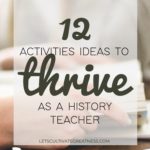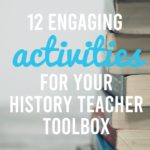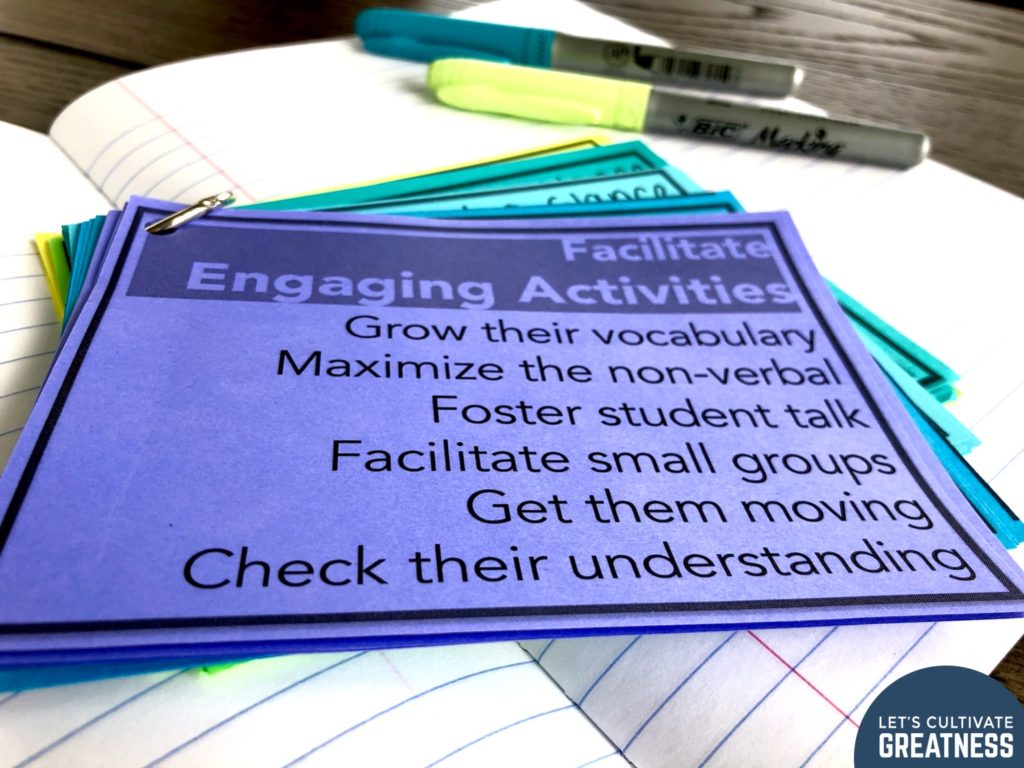Example of What Teachers Do to Motivate Students in the Clasroom Clip Art Funny


Content tin be a killer.
Information technology dominates everything in secondary social studies. Only that doesn't mean information technology has to be all drill and kill.
While PBL and thematic units are my jam, I besides know the grind of beingness held tightly to the standards with a high-stakes test at the finish. Only having an cease-of-course test doesn't mean yous tin't yet spark genuine intrigue and inquiry in your students. I firmly believe (and brain researchers confirm!) that real learning happens in the small daily challenges of an engaging lesson.
I am sharing my top 12 favorite engaging activities with you. These are easily used across many subject area areas, depression-prep, and (all-time of all) re-usable throughout the year. That's like the holy grail, am I right? They are grouped together into vocabulary, non-verbal, kinesthetic, and comprehension activities.
All of these activities, plus a ton more, are available in a crazy cool and easy-to-use flip deck. I use this ALL THE TIME when I'm penciling in my weekly lessons. If I don't, things seem to get repetitive and boring actually quickly.

Grow their Vocabulary
We all know vocabulary is central to learning growth. Everything we ask of students involves some attribute of writing, reading, or speaking the "right" words. Even math tests are part reading tests. If your students don't have the words, they are leap to fail from the start. So let's practice the words!
Activity 1: Describe A to Z
This one works perfectly at the start or the end of a unit (or both!), depending on how y'all use it. Regardless of the unit's topic, in that location is some wide concept at its core: slavery, democracy, civil rights, war, etc. On the first day, assign each student a letter of the alphabet, and accept them think of a give-and-take that starts with that letter based on what they already know or retrieve they know about the concept. It can be a great discussion starter as well every bit determinative assessment of students' mindsets.
Alternatively, at the terminate of the unit assign (or reassign) all the letters and have students select a word based on what they have learned. If you recorded words at the get-go of the unit this is a swell fashion to show them their growth.
Activity 2: What's the Password?
Brandish a pool of words on your wall. These could exist either unit-specific content vocabulary or from a list of should-know academic words. Whenever a pupil needs a pencil or wants a bathroom pass or any other blazon of asking, challenge them to apply i of the words properly. If you choose academic words, challenge students to find ways to incorporate the words into their discussions and writings.Would yous say he sounds pugnacious?
Activity iii: Roll the Dice
This could be a formal review game in pocket-sized groups, or an on-the-fly bong ringer or exit activity with a couple selected student in front of the course. Designate each number of a die to a different task related to the concept you are covering. Then, challenge students to roll the dice. Here's i option:
1 = define the concept
2 = draw an example of the concept
3 = provide a synonym of the concept
4 = provide an anonym of the concept
5 = draw a picture of the concept
6 = act out the concept
Take the other students guess the term. This is a super like shooting fish in a barrel and interactive way to get them talking most concepts from all sorts of angles.
Maximize non-verbal strategies
This i is especially of import in the high school setting as listening, talking, reading, and writing boss the curriculum. If we want students to understand new and ofttimes-abstract ideas and concepts, then nosotros demand to be cognizant of including spatial, visual, and tactile strategies.
In a study where participants were asked to memorize a series of words (dog, bike, lemon), those who were encouraged to visualize the words (a dog riding a bike while eating a lemon) could retrieve the words at a significantly higher rate. Not merely are learning deeper and retrieval easier, merely the time to learn a new concept is shortened when visuals are included. Talk about a win-win!
Activeness four: Shape the Learning
Stash a pack of pipe cleaners or tiny tubs of playdough in your cupboards. Challenge students in pairs or pocket-size groups to create something three-dimensional that represents what they have learned. For case, accept students shape the i prized possession an Ellis Island immigrant may have packed in their suitcase. Or, an object that represents a right from the Bill of Rights. Endless possibilities!
A popular example of this shaping technique involves arranging gummies bears to learn unlike forms of governments.
Activity 5: Color It
Discover ways to colour code reoccurring things through a whole unit or even the whole course, either through your use of colored paper or through students marking text with certain colors. For example, during your WWII unit, code anything well-nigh the Centrality Powers in i color, Allied Powers in some other.
Or, take students read an extended passage, color-coding for dissimilar things, similar statistical prove and quotes, or push and pull factors.
Or my favorite, copy the aforementioned worksheet in unlike colors, requiring students to become up and find a new partner with a unlike color for every step.
Activity 6: Choice an Object
Stash a handbasket in your classroom with a random array of inanimate objects: a basketball game, paper clip, lip gloss, sticky notes pad, measuring cup, any! Bring information technology out every one time in a while, and have students connect what they have learned to one of the objects. Or ask students which object most represents their understanding at that moment of the lesson or unit, whether it is a mid-unit check-in, or the day before a big project is due.
Occasionally change out the objects to keep things interesting.
Get them moving
We know that different parts of the encephalon store different parts of our knowledge. And now brain researchers take confirmed that the brain reconstructs memories by borer into those cross-encephalon connections. The more than connections (like pairing physical movements with memorizing facts), the stronger the understanding and the easier information technology is to retrieve the stored information. Not but that, but move has been found to increase students' motivation and morale, besides!
Activity 7: This or That
This is as great bell ringer, exit ticket, or mid-class determinative check. Pose a forced selection or a "yes" or "no" question and designate each side of the room as the answers. Students walk to the side of the room to limited their reply. Once there, challenge students to collaborate and share out the strongest reason for their answer, ask a question of the other side, offer a rebuttal, etc.
This is so powerful that I will find myself gesturing to the sides of the rooms for the whole balance of the unit of measurement when revisiting the topic.
Questions can be every bit specific as asking almost a certain primary source:"Do you agree or disagree with the political cartoonist's message?"
Or questions tin can exist cardinal to your whole unit:"Was President Jackson a Mutual Man or an elitist?" This kind of question is keen to revisit a couple of times throughout the unit to see if students' nigh contempo learning causes them to modify their position. Very powerful!
Activity 8: Walk the Line
This is the next level to "This or That," yet still super piece of cake to practise.
Head out to the hallway and throw string or masking tape on the flooring. Mark one end 100% or Absolutely Aye, mark the other 0% or Absolutely No. Accept students express their answer by heading to the spot along the continuum line that represents their feeling. The merely difference from This or That is that at present yous are phrasing your questions so students can quantify their answers:
"How well did President Hoover address the problems of the Swell Low during his administration?"
"How democratic is the Electoral College?"
If students need help identifying corporeality qualifiers (and most do!), this continuum line word wall is a game changer! I couldn't imagine teaching without upwardly in my classroom.
Action ix: Expand the Walls
Think past your classroom walls for where students could complete the day's lesson: the hallway, gym, sidewalk, eatables surface area, field, or courtyard.How might those locations actually improve the touch on of the lesson?
Some ideas to become you thinking with common activity options:
Sidewalk or courtyard: completing chalk talk, concept mapping, or hashtags and vi-word novels (come across below!) in sidewalk chalk
Hallway: hosting silent learning stations or gallery walks
Auditorium seats: providing extended silent reading
Gym or deli: facilitating several simultaneous pocket-sized-group discussions
Check for student understanding
No, this doesn't mean a drill of questions with unmarried answers. At that place are so many more open-ended, creative, nonetheless no-prep-time-needed ways to gauge student agreement, while simultaneously expanding it in new ways. If you know Marzano, you know that summarizing is one of his ix High Yield Strategies, but if you simply terminate in that location yous actually aren't engaging students. It's in the making of new meaning that intrigue and deep learning truly happen.
Activity ten: Circle the I
This works smashing subsequently students take finished reading a longer text or filling in a full-page graphic organizer of notes. Have students zoom out and look at the work every bit a whole. Then, claiming them to make a determination by selecting one paragraph, judgement, bullet point, slice of show, quote, etc. and either circle or highlight. Your claiming should pose a chore that includes a decision-making evaluation word: best/worst, near/to the lowest degree, biggest/smallest, strongest/weakest.
This works and then well because students' answers volition vary and sometimes demonstrate pretty out-of-the-box thinking when yous ask them to explain.
I use this ane all the time so that my students have their evidence and thinking already decided when we caput into end-of-unit review and essay outlining.
Activity eleven: Six-Word Novel
As the story goes, Ernest Hemingway was challenged to write a six-word novel. He came up with:"For sale: infant shoes, never worn."
While this action could be used in a variety of contexts, I like using it at the end of a unit. Particularly in my immigration unit, where we study how to examine history through storytelling.
I assign students to write a six-word novel for one of the immigrant groups we've studied and then for immigrant story as a whole. So, then powerful.
Plus, these are fantastic to display on a message lath afterwards.
Activity 12: #Hashtag
Not too dissimilar from the type of artistic thinking required for a six-discussion novel and e'er a favorite of my students, especially the wittier ones. I like this one because information technology connects their learning to either something previously learned or to a current issue or cultural reference. This action tin also be used as a quick bell ringer or exit ticket, or during a unit review.
Show a few examples of real-life tweets that model the connection-making, simply likewise the wit that make it a perfectly funny, ironic, or satirical hashtag. Or create some of your own examples using content from a previous unit.
Have students jot their hashtags down at the pinnacle or end of an consignment or along the side of a written text. At presentthis is annotating!
Share the best ones the next twenty-four hours. Their thinking might even provide you lot some entertaining message board cloth!
I hope these action ideas give y'all the starting point or reboot you need to exist an awesome teacher!
Click below to take hold of my complete 48-menu Engaging Activities flip deck for more great ideas in one easy reference tool!

Image credit: Sarah Noltner
williamscondets1989.blogspot.com
Source: https://letscultivategreatness.com/12-classroom-activities-that-awesome-social-studies-teachers-use/
0 Response to "Example of What Teachers Do to Motivate Students in the Clasroom Clip Art Funny"
Enregistrer un commentaire